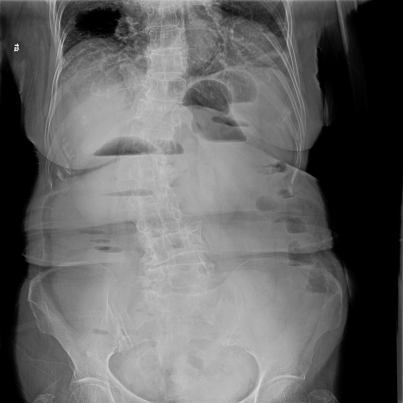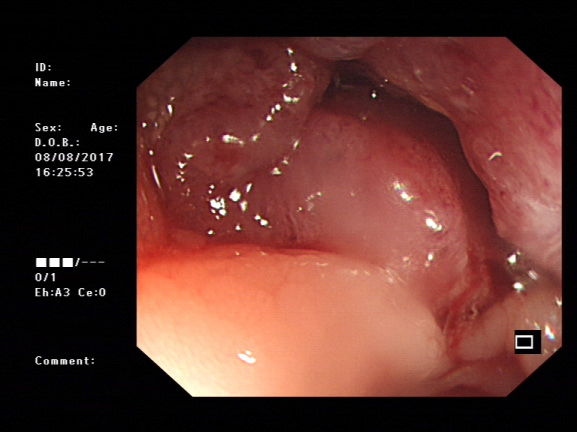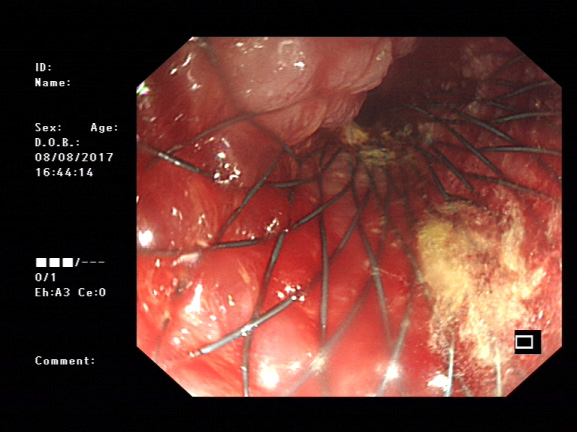eISSN: 2373-6372


Case Report Volume 8 Issue 1
1Zhongda Hospital, Southeast University, China
2North Middlesex University Hospital, UK
3Institute of Infection and Global Health, University of Liverpool, UK
Correspondence: Zhi Wang, Zhongda Hospital, Medical School, Southeast University, Nanjing 210009, China
Received: September 25, 2017 | Published: December 1, 2017
Citation: Wang Z, Tao Q, Wang SS, Chen H, Wang G (2017) A Case Report of Elective Surgery after Intestinal Stent Implantation in Left Colorectal Cancer. Gastroenterol Hepatol Open Access 7(7): 00270. DOI: 10.15406/ghoa.2017.08.00270
Left-sided colon cancer often presents with acute intestinal obstruction as the first symptom and requires emergency surgery.1 Surgery most commonly involves two stages: (1) removing the tumor and making the abdominal wall fistula; (2) closing the fistula 3-6month late.2 This procedure can cause a great deal of trauma and discomfort from the fistula and secondary surgical procedure as well as increased financial burden to patients in privatised healthcare systems. Recently, we have used stents to ease obstruction first and the performed elective surgery when patients’ general status became more suitable for a surgical procedure. Satisfactory results have been achieved. Here we show a typical case.
80year old lady was hospitalised due to abdominal pain and vomiting lasting 9hours. Routine blood tests showed: white blood cells 14.05 * 109 / L, neutrophils 87.2%, amylase 573IU / L. ECG showed: 1, sinus rhythm 2, T wave abnormality 3, incomplete right bundle branch block. Abdominal X-ray showed dilation of the small intestine with multiple ladder-like fluid levels (Figure 1), supporting the diagnosis of colon obstruction. Abdominal CT showed: 1, local thickening of the sigmoid colon with mild exudative changes and multiple small surrounding lymph nodes. The patient has been hypertensive for many years with a history of cerebral infarction. After admission, the patient suffered from repeated episodes of vomiting, and increasing abdominal pain. On physical examination active bowel sounds were not present and there was no significant tenderness or rebound tenderness.

Figure 1 Abdominal X-ray showed dilation of the small intestine with multiple ladder-like fluid levels.
Colonoscopy was performed. The colon became too narrow to pass the scope at 30cms from the anus. Erosive haemorrhagic mucosa was seen and colon cancer was diagnosed. To relieve its obstruction, a stent (80x25mm) was implanted into the narrow lumen. Liquids were then passed through the stent, indicating the obstruction was resolved (Figure 2). One week late, the patient’s general condition became much better and colectomy was performed (Figure 3). The segment with cancer was removed and the patient gained full recovery without complication (Figure 4) and was discharged within one week after colectomy.


Figure 2 Left: sigmoidal colon lesion before inserting stent. Right: after insertion of stent. Liquids were then passed through the stent, indicating the obstruction was resolved.
Pathological examination showed colon adenocarcinoma, 5.5cm × 3cm × 0.6cm, invading whole layer of colon wall whilst no cancerous cells were found in the 20 lymph nodes removed. There was no clear tumor thrombus in the blood vessels but some surrounding nerves were invaded by cancer cells. Pathological stage: IIIB (T3, N1c, M0). Immuno-histochemical staining: Her2 (2 +), P53 (mutant), Ki67 (+80%), MLH1 (+), MSH2 (+), MSH6 (+), PMS2 (+).
About 7-30% left-sided colon cancer patients present in the form of colon obstruction,3 and they often require emergent surgical treatment. This is a high risk procedure due to the poor general health condition caused by intestinal obstruction, fluid and electrolyte imbalances, hypoproteinemia and other concomitant diseases. In these cases, post-operative complications, such as infection, intestinal fistula, are common. In order to reduce complications, emerged two staged approach has been widely adopted, i.e. colectomy with artificial fistula in the first stage, then closing the fistula in the second stage. However this approached means patients have to endure the inconvenience of having a fistula and also undergo two large surgical procedures. The whole treatment lasts longer and becomes more costly to the patient in terms of medical fees, and potential lost income. Since 1999, Mainar et al.,4 54 reported the use of stents for rectal malignancy to relieve obstruction prior to colectomy and its advantage has been recognised and widely used.5–13 In this case, the stent was implanted during the first colonoscopy and immediately relieved the obstruction. The patient then had a normal diet and her general condition was greatly improved. She was ready for an elective colectomy within one week. When a better general condition was achieved, the risks from the operation were reduced and her prognosis was improved.
Self-extendable stent14 can be used as a bridge15,16 of obstructive colon cancer followed by colectomy or for advanced cancer for improving life quality. With the widely usage, the stent itself has also been improved. In certain cases, stent coated with radiative particles to prevent cancer cell growing has also been developed and tested.17,18 With technology advanced, it will be used more and more extensively for colorectal obstructive diseases. However using stent as a bridge for preparation of colectomy is the most suitable one and has been demonstrated to have the most beneficial effect.11,16,19
The complications of using colon stent are rare. Bleeding, perforation, stent fall off or re-obstruction, etc have been reported as complications of stent implantation.20–23 However, stent implantation is safe in general. Esparrach24 reported that using stents for less than a week before surgical treatment could significantly reduce its complications. Sagar's Cochrane Review25 retrospectively analysed patients with colon stent implantation and showed that that its effective rate was about 86 %. Tan's26 reported that procedure and clinical success rates of colon stents were all about 70 %. Roberto Cirocchi21 reported that colon stent implantation before colectomy was more often used than emergence colectomy with artificial fistula.21 In this case, there was no complication caused by stent implantation or colectomy consistent with the literature reported.
Intestinal stent implantation for left-sided colon cancer with obstruction is safe and effective, and can increase the success of colectomy. Therefore it should be recommended as the first choice of treatment.
All authors declare no conflict of interest.
Nanjing Micro-Tech, Ltd, Nanjing 210032, China, Tel: 0086 25 58646375; Email: info@micro-tech.com.cn; http://www.micro-tech.com.cn
None.

©2017 Wang, et al. This is an open access article distributed under the terms of the, which permits unrestricted use, distribution, and build upon your work non-commercially.